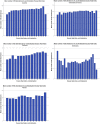The use of an 'acclimatisation' heatwave measure to compare temperature-related demand for emergency services in Australia, Botswana, Netherlands, Pakistan, and USA
- PMID: 30921372
- PMCID: PMC6438466
- DOI: 10.1371/journal.pone.0214242
The use of an 'acclimatisation' heatwave measure to compare temperature-related demand for emergency services in Australia, Botswana, Netherlands, Pakistan, and USA
Abstract
Background: Heatwaves have been linked to increased risk of mortality and morbidity and are projected to increase in frequency and intensity due to climate change. The current study uses emergency department (ED) data from Australia, Botswana, Netherlands, Pakistan, and the United States of America to evaluate the impact of heatwaves on ED attendances, admissions and mortality.
Methods: Routinely collected time series data were obtained from 18 hospitals. Two separate thresholds (≥4 and ≥7) of the acclimatisation excess heat index (EHIaccl) were used to define "hot days". Analyses included descriptive statistics, independent samples T-tests to determine differences in case mix between hot days and other days, and threshold regression to determine which temperature thresholds correspond to large increases in ED attendances.
Findings: In all regions, increases in temperature that did not coincide with time to acclimatise resulted in increases in ED attendances, and the EHIaccl performed in a similar manner. During hot days in California and The Netherlands, significantly more children ended up in the ED, while in Pakistan more elderly people attended. Hot days were associated with more patient admissions in the ages 5-11 in California, 65-74 in Karachi, and 75-84 in The Hague. During hot days in The Hague, patients with psychiatric symptoms were more likely to die. The current study did not identify a threshold temperature associated with particularly large increases in ED demand.
Interpretation: The association between heat and ED demand differs between regions. A limitation of the current study is that it does not consider delayed effects or influences of other environmental factors. Given the association between heat and ED use, hospitals and governmental authorities should recognise the demands that heat can place on local health care systems. These demands differ substantially between regions, with Pakistan being the most heavily affected within our study sample.
Conflict of interest statement
The authors have declared that no competing interests exist.
Figures
Similar articles
-
Systematic review of the impact of heatwaves on health service demand in Australia.BMC Health Serv Res. 2022 Jul 28;22(1):960. doi: 10.1186/s12913-022-08341-3. BMC Health Serv Res. 2022. PMID: 35902847 Free PMC article.
-
Heat and emergency room admissions in the Netherlands.BMC Public Health. 2018 Jan 5;18(1):108. doi: 10.1186/s12889-017-5021-1. BMC Public Health. 2018. PMID: 29304777 Free PMC article.
-
The impact of summer temperatures and heatwaves on mortality and morbidity in Perth, Australia 1994-2008.Environ Int. 2012 Apr;40:33-38. doi: 10.1016/j.envint.2011.11.011. Epub 2011 Dec 27. Environ Int. 2012. PMID: 22280925
-
Review article: Scoping review of the characteristics and outcomes of adults presenting to the emergency department during heatwaves.Emerg Med Australas. 2023 Dec;35(6):903-920. doi: 10.1111/1742-6723.14317. Epub 2023 Oct 3. Emerg Med Australas. 2023. PMID: 37788821
-
Responding to heatwave intensity: Excess Heat Factor is a superior predictor of health service utilisation and a trigger for heatwave plans.Aust N Z J Public Health. 2015 Dec;39(6):582-7. doi: 10.1111/1753-6405.12421. Epub 2015 Aug 10. Aust N Z J Public Health. 2015. PMID: 26260877
Cited by
-
Extreme heat and pediatric health in a warming world: a space-time stratified case-crossover investigation in Ontario, Canada.Environ Health. 2025 Jun 7;24(1):35. doi: 10.1186/s12940-025-01153-y. Environ Health. 2025. PMID: 40483440 Free PMC article.
-
Increasing global temperatures threaten gains in maternal and newborn health in Africa: A review of impacts and an adaptation framework.Int J Gynaecol Obstet. 2023 Feb;160(2):421-429. doi: 10.1002/ijgo.14381. Epub 2022 Aug 16. Int J Gynaecol Obstet. 2023. PMID: 35906840 Free PMC article. Review.
-
Heat illness data strengthens vulnerability maps.BMC Public Health. 2021 Nov 3;21(1):1999. doi: 10.1186/s12889-021-12097-6. BMC Public Health. 2021. PMID: 34732187 Free PMC article.
References
-
- Perkins S, Alexander L, Nairn J. Increasing frequency, intensity and duration of observed global heatwaves and warm spells. Geophysical Research Letters. 2012;39(20).
-
- Herold N, Ekström M, Kala J, Goldie J, Evans J. Australian climate extremes in the 21st century according to a regional climate model ensemble: Implications for health and agriculture. Weather and Climate Extremes. 2018;20:54–68.
-
- Editorial. Health professionals: be prepared for heatwaves. Lancet. - PubMed



